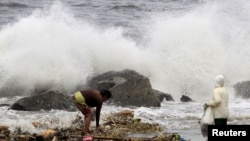The Philippines is one of the most vulnerable countries to natural disasters, with a population spread across some 7,100 islands and about a quarter of its people living in poverty. That is why the nation routinely hosts international conferences aimed at addressing ways to mitigate the impact of disasters – wherever they may occur.
This week, ministers of the 21-member economies at the Asia-Pacific Economic Cooperation (APEC) forum on energy resiliency are in the central city Cebu discussing ways to ensure power is up and running when disaster strikes.
And in Manila, disaster risk managers, are discussing how to address food shortages brought on by emergencies.
The World Food Program’s (WFP) Philippine Country Director Parveen Agrawal said in the Philippines keeping hunger at bay is a priority during crisis, especially when typhoons and other natural disasters hit.
“If you look at Pablo [Typhoon Bopha], if you look at before, Ondoy [Tropical Storm Ketsana], you look at other crises that have hit the country, Haiyan [super typhoon]; the first need is food to stabilize, to get lives back in order,” Agrawal told VOA in an interview on the conference sidelines.
According to the 2014 World Risk Index, the Philippines was second on the list of 171 countries most exposed to natural disasters. The South Pacific island nation Vanuatu was first.
Preparation starts with prediction
For the past four years, USAID, a United States government development assistance agency, has been giving the WFP $5 million each year for programs aimed at helping countries prepare for disasters. Some projects help predict weather events so the country can make ready ample food stocks ahead of emergencies.
There are also measures to help address the predictable logistical bottlenecks that can occur when huge numbers of people suddenly are without food.
In the aftermath of Super Typhoon Haiyan in 2013, hundreds of volunteers manually assembled tens of thousands of food care packages that needed to reach more than a hundred thousand families per day across the central Philippines.
The WFP has helped fund a project for a mechanized emergency food packing system for the Philippines social welfare department. The system can prepare up to 50,000 packages in a 24-hour period, a volume that officials said would come in handy after the experience of Haiyan.
The typhoon sliced through the central Philippines with 315 kilometer per hour winds and five meter storm surges, leaving more than 7,300 people dead or missing. Days after it struck, communications and transportation links remained broken, keeping workers and food from reaching those most in need.
Following those experiences, Philippine Social Welfare and Development Secretary Corazon Soliman said her office has streamlined logistics and warehousing of goods for easier distribution, trained quick-response teams not in the affected areas that could mobilize immediately after disaster strikes and set up alternative communication methods. She said sharing the experiences from past disasters can help prepare for future ones.
U.S. Energy Deputy Secretary Liz Sherwood-Randall said there is also a need for governments to collaborate with the private sector, simulating disaster scenarios to help anticipate problems.
In an interview with VOA, she said countries like the Philippines should do a comprehensive assessment of their energy infrastructure so they could “identify risks and opportunities” and look at ways to mitigate power outages, or try to shorten periods when power is lost.
In Disaster-Prone Philippines, Mitigating Next Crisis by Anticipating It
- By Simone Orendain

MANILA —








